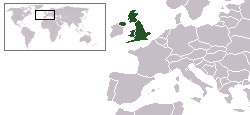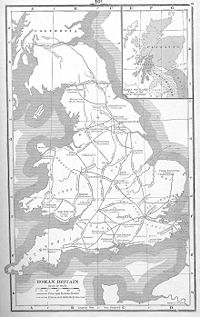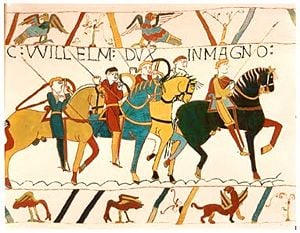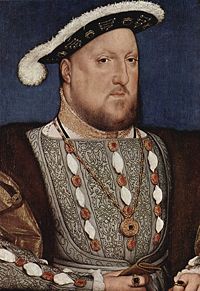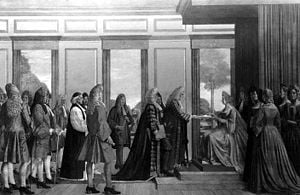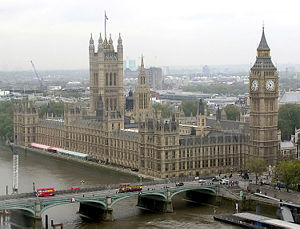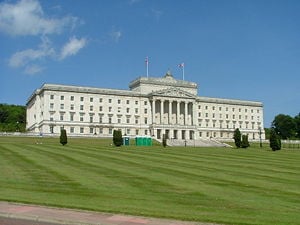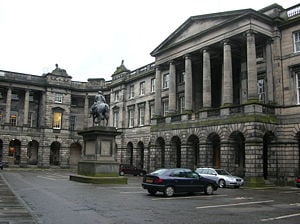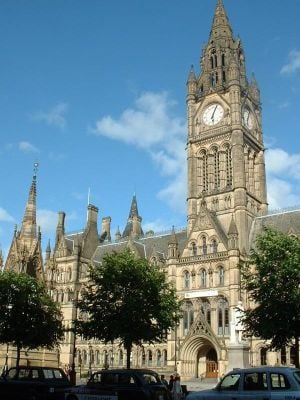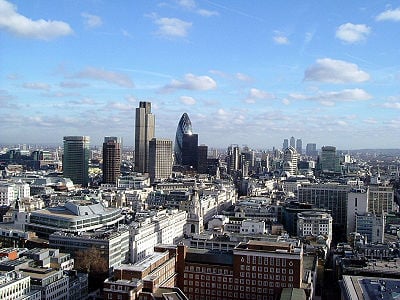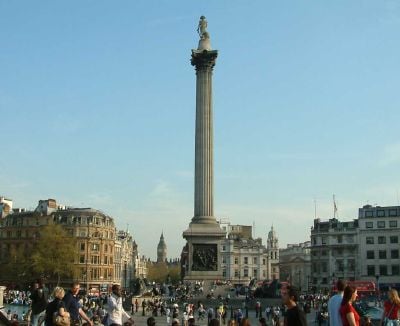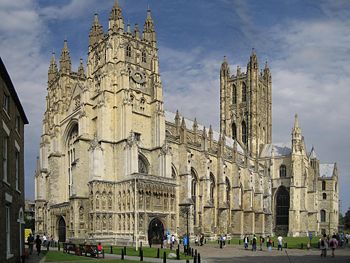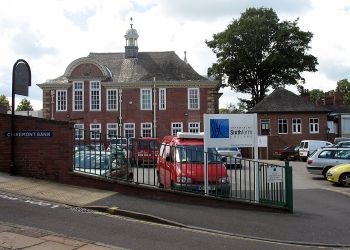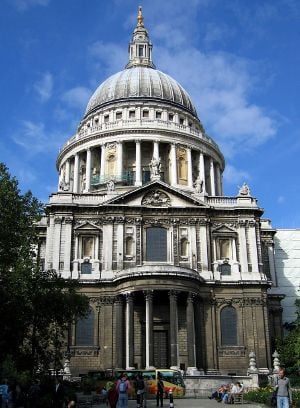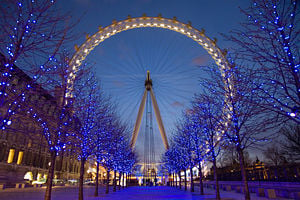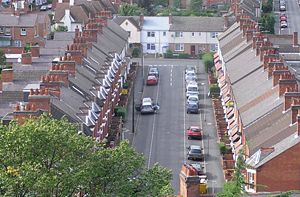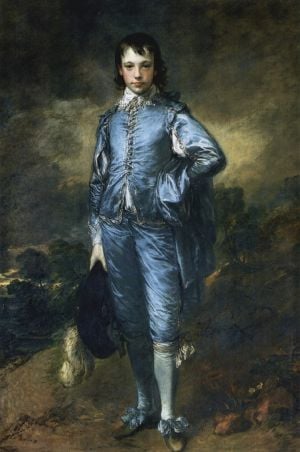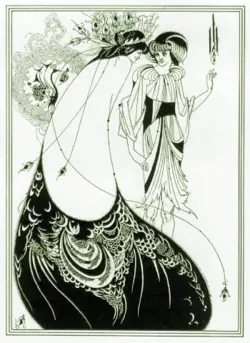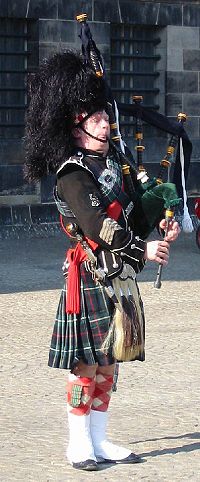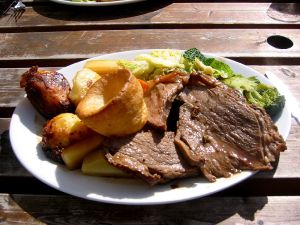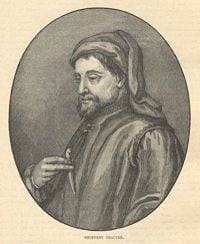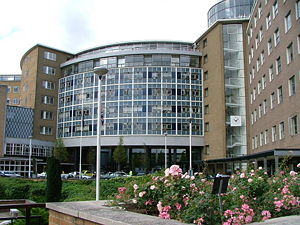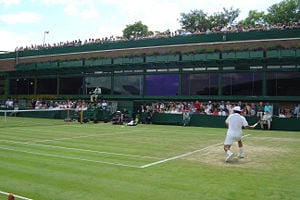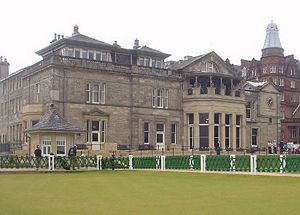Difference between revisions of "United Kingdom" - New World Encyclopedia
Mike Butler (talk | contribs) m |
Mary Anglin (talk | contribs) (submit) |
||
| Line 1: | Line 1: | ||
| − | {{Claimed}}{{Contracted}} | + | {{Submitted}}{{Claimed}}{{Contracted}} |
{{Infobox Country | {{Infobox Country | ||
|native_name = <span style="line-height:1.33em;">United Kingdom of Great Britain<br>and Northern Ireland<sup>1</sup></span> | |native_name = <span style="line-height:1.33em;">United Kingdom of Great Britain<br>and Northern Ireland<sup>1</sup></span> | ||
Revision as of 14:48, 25 August 2007
| United Kingdom of Great Britain and Northern Ireland1 |
||||||
|---|---|---|---|---|---|---|
|
||||||
| Motto: Dieu et mon droit (the Royal motto3) (French for "God and my right") |
||||||
| Anthem: God Save the Queen 4 |
||||||
| Capital | London | |||||
| Largest Most populous conurbation | Greater London Urban Area | |||||
| Official languages | English (de facto5) | |||||
| Government | Constitutional monarchy | |||||
| - | Queen | HM Queen Elizabeth II | ||||
| - | Prime Minister | The Rt Hon Gordon Brown MP (Labour) | ||||
| Formation | ||||||
| - | Union of the Crowns | 24 March 1603 | ||||
| - | Acts of Union | 1 May 1707 | ||||
| - | Act of Union | 1 January 1801 | ||||
| - | Anglo-Irish Treaty | 12 April 1922 | ||||
| EU accession | 1 January 1973 | |||||
| Area | ||||||
| - | Total | 244,820 km² (79th) 94,526 sq mi |
||||
| - | Water (%) | 1.34 | ||||
| Population | ||||||
| - | 2005 estimate | 60,209,5006 (21st) | ||||
| - | 2001 census | 58,789,194 | ||||
| GDP (PPP) | 2005 estimate | |||||
| - | Total | $1.833 trillion (6th) | ||||
| - | Per capita | $30,436 (18th) | ||||
| GDP (nominal) | 2005 estimate | |||||
| - | Total | $2.201 trillion (5th) | ||||
| - | Per capita | $37,023 (13th) | ||||
| Currency | Pound sterling (£) (GBP) |
|||||
| Time zone | GMT (UTC+0) | |||||
| - | Summer (DST) | BST (UTC+1) | ||||
| Internet TLD | .uk7 | |||||
| Calling code | +44 | |||||
| 1 In the UK, some other languages have been officially recognised as legitimate autochthonous (regional) languages under the European Charter for Regional or Minority Languages. In each of these, the UK's official name is as follows: Welsh: Teyrnas Unedig Prydain Fawr a Gogledd Iwerddon Scottish Gaelic: An Rìoghachd Aonaichte na Breatainn Mhòr agus Eirinn a Tuath Irish: Ríocht Aontaithe na Breataine Móire agus Thuaisceart Éireann Scots: Unitit Kinrick o Great Breetain an Northren Ireland Cornish: An Rywvaneth Unys a Vreten Veur hag Iwerdhon Glédh 2 There is also a variant for use in Scotland; see Royal coat of arms of the United Kingdom. 3 The Royal motto used in Scotland is Nemo Me Impune Lacessit (Latin: "No-one provokes me with impunity"). 4 See #Symbols below. It also serves as the Royal anthem. 5 In addition to English (use established by precedent), Welsh is recognised in Wales as a "language of equal standing"[citation needed]. Since 2005, Scottish Gaelic in Scotland has the status of "an official language of Scotland commanding equal respect to the English language" [1]. See also Languages in the United Kingdom. 6 Official estimate provided by the UK Office for National Statistics [2]. 7 ISO 3166-1 alpha-2 is GB, but .gb is unused. The .eu domain is also shared with other European Union member states. |
||||||
The United Kingdom of Great Britain and Northern Ireland (usually shortened to the United Kingdom, the UK, or Britain) is a country and sovereign state that is situated in west Northern Europe.
The United Kingdom is a political union made up of three constituent countries: England, Scotland, Wales, and includes six of the nine counties of Ulster Northern Ireland. The United Kingdom also has several overseas territories, including Bermuda, Gibraltar, Montserrat and Saint Helena among others.
A constitutional monarchy, the United Kingdom is a Commonwealth Realm, sharing the same person — Queen Elizabeth II — with the 15 other Realms as monarch and head of state.
A member of the G8, the United Kingdom is a highly developed country with the fifth largest economy in the world and second largest in Europe, estimated at US$2.2-trillion. It is the third most populous state in the European Union with a population of 60.2 million.
The history of the United Kingdom, and its predecessor states, includes numerous key events that have had a lasting impact of world culture. These include the signing of Magna Carta, leading involvement in the Protestant Reformation, and the long fight to establish religious freedom, the development of private property rights, constitutional law, and parliamentary democracy.
Unlike many countries today, which are officially secular, the UK is officially a Christian country, although it has one of the lowest levels of public worship attendance in the world.
Geography
Located primarily on the island of Great Britain and in Northern Ireland, the United Kingdom is bounded by the Atlantic Ocean, the North Sea, the English Channel, the Celtic Sea, and the Irish Sea. The mainland is linked to France by the Channel Tunnel and Northern Ireland shares a land border with the Republic of Ireland.
With a land area of 94,526 square miles (244,820 square kilometres), the United Kingdom is slightly smaller than Oregon in the United States.
Most of England consists of rolling lowland terrain, divided east from west by more mountainous terrain in the Northwest (Cumbrian Mountains of the Lake District) and north (the upland moors of the Pennines) and limestone hills of the Peak District by the Tees-Exe line.
Scotland's geography] is varied, with lowlands in the south and east and highlands in the north and west, including Ben Nevis. There are many long and deep-sea arms, firths, and lochs. Scotland has nearly 800 islands, mainly west and north of the mainland, notably the Hebrides, Orkney Islands and Shetland Islands.
Wales (Cymru in Welsh) is mostly mountainous, the highest peak being Snowdon (Yr Wyddfa) at 3560 feet (1085 meters) above sea level. North of the mainland is the island of Anglesey (Ynys Môn). Northern Ireland, making up the north-eastern part of Ireland, is mostly hilly.
The 10 tallest mountains in the UK are all found in Scotland. The highest peaks is Ben Nevis (in the Nevis Range), at 4406 feet (1344 meters). There is no peak in England that is 3300 feet (1000 meters) or greater, the highest mountain being Scafell Pike in England's Lake District, at some 3208 feet (978 meters) The lowest point is in the Fens of East Anglia, in England, parts of which lie up to 13 feet (4 meters) below sea level.
It is estimated that the UK is made up of over 1000 small islands, some being natural and some being man-made crannogs, which were built in past times using stone and wood and which were enlarged by natural waste building up over time.
The climate is generally temperate, though significantly warmer than some other locations at similar latitude, such as central Poland, due to the warming influence of the Gulf Stream. The south is warmer and drier than the north.

The prevailing winds are south-westerly, from the North Atlantic Current. More than 50 percent of the days are overcast. There can be strong winds and floods, especially in winter.
Average annual rainfall varies from over 120 inches (3000 millimeters) in the Scottish Highlands down to 21.8 inches (553mm) in Cambridge. The county of Essex is one of the driest in the UK, with an average annual rainfall of around 24 inches (600mm) although it typically rains on over 100 days per year.
The highest temperature recorded in the UK was 101.3°F (38.5°C) at Brogdale, near Faversham, in the county of Kent, on August 10, 2003. The lowest was -17.0°F (27.2°C) recorded at Braemar in the Grampian Mountains, Scotland, on February 11, 1895.
The United Kingdom, along with the rest of Europe, has been hit by heat waves during the summer, causing numerous deaths, with temperatures nearing the 104°F (40°C) mark.
The longest river is the River Severn, at 220 miles (354km), which flows through both Wales and England. The largest lakes are: Lough Neagh in Northern Ireland (147.39 square miles), Loch Lomond in Scotland (27.46 square miles), Lake Windermere in England (5.69 square miles) and 14.74 km²), and Lake Vyrnwy in Wales 3.18 square miles.
The United Kingdom has an extensive system of canals, mostly built in the early years of the Industrial Revolution, before railways were built. There are numerous dams and water reservoirs to store water for drinking and industry. The generation of hydroelectric power is rather limited, supplying less than two percent of British electricity, mainly from the Scottish Highlands.
Originally, oak forests covered the lowlands, while pine forests and patches of moorland covered the higher or sandy ground. Much forest has been cleared for cultivation, so that by 2007, only about 9 percent of the total surface is wooded — in east and north of Scotland and in southeast England. Oak, elm, ash, and beech are the most common trees in England, while pine and birch are common in Scotland. Heather, grasses, gorse, and bracken predominate on the moorlands.
Wolves, bears, boars, and reindeer are extinct, but red and roe deer are protected for sport. Foxes, hares, hedgehogs, rabbits, weasels, stoats, shrews, rats, and mice are common, otters are found in many rivers, and seals appear along the coast. The chaffinch, blackbird, sparrow, and starling are the most numerous of the 230 species of birds there, and another 200 are migratory. Game birds — pheasants, partridges, and red grouse — are protected. The rivers and lakes contain salmon, trout, perch, pike, roach, dace, and grayling.
Agriculture is intensive, highly mechanised, and efficient by European standards, producing about 60 percent of food needs with only one percent of the labour force. It contributes around two percent of GDP. Around two thirds of production is devoted to livestock, and one third to arable crops.
The UK has large coal, natural gas, and oil reserves, plus limestone, chalk, gypsum,silica, rock salt, china clay, iron ore, tin, silver, gold, lead, as well as arable land, wheat, barley, hill farms, sheep
The United Kingdom is reducing greenhouse gas emissions. It has met Kyoto Protocol target of a 12.5 percent reduction from 1990 levels and intends to meet the legally binding target of a 20 percent cut in emissions by 2010. Between 1998-1999 and 1999-2000, household recycling increased from 8.8 percent to 10.3 percent.
London is the capital city of England and the United Kingdom. The ancient City of London retains its tiny mediaeval boundaries; but the name "London" has long applied more generally to the whole metropolis which has grown up around it. London, with a population of 7.7 million, is today one of the world's leading business, financial and cultural centres, and its influence in politics, education, entertainment, media, fashion and the arts all contribute to its status as one of the major global cities
Edinburgh, with a population of 448,624 in 2001, is the capital of Scotland, Cardiff, with a population of 380,000 in 2007, is the capital of Wales, and Belfast, with a population of 579,554 in 2001, is the capital of Northern Ireland.
History
Cro-Magnons (the first anatomically modern humans) are believed to have arrived in Europe about 40,000 years ago, and lived in the region that was to become the United Kingdom by 27,000 years ago. Up to around 6000 B.C.E., the islands were connected to Europe, and were easily accessible by nomadic hunter-gatherers. Around 4000 B.C.E., Neolithic immigrants brought agriculture, used stone tools, buried their dead in communal graves of stone or mounds of earth, and conducted rituals at henge monuments. From around 2300 B.C.E., Beaker folk, who buried their dead in individual graves, often with a drinking vessel, arrived from the Low Countries and middle Rhine. These people knew how to work copper and gold. Wessex chieftains dominated trade, and ensuing prosperity enabled these chieftains to build the large bluestone monoliths known as Stonehenge.
The Celts
From the eighth century B.C.E., Celts arrived, and hill forts began to appear. A succession of migrations took place from 700 B.C.E. to 400 B.C.E. Settlements had a traditional round house, and farming was characterized by small fields, and storage pits for grain. Iron daggers were made, then swords, and with increasing pressure on resources, increasing numbers of hill forts were built.
Romans invade
The first Roman invasion of the British Isles was led by Julius Caesar in 55 B.C.E.; the second, a year later in 54 B.C.E. Although no territory was taken for the Roman Empire on either occasion, this was the start of the Roman settlement of Britain. The Romans had many supporters among the Celtic tribal leaders, who agreed to pay tributes to Rome in return for Roman protection. The Romans returned in 44 C.E., led by Claudius, this time establishing control, and establishing a province Britannia. Initially an oppressive rule, gradually the new leaders gained a firmer hold on their new territory which at one point stretched from the south coast of England to Wales and as far away as Scotland (though they did not hold the latter for long). Hadrian's Wall, built on the Solway-Tyne isthmus (122 C.E.-130 C.E.) marked the frontier of Roman civilisation.
Over the approximately 350 years of Roman occupation of Britain, the majority of settlers were soldiers garrisoned on the mainland. It was with constant contact with Rome and the rest of Romanised Europe through trade and industry that the native Britons themselves adopted Roman culture and customs.
Christianity introduced
Roman merchants and soldiers introduced a variety of cults, including Christianity, which made little headway until the late fourth century, initially among wealthy villa owners. By the end of Roman rule, in 410 C.E., Christianity had made headway there, but the leaders followed the teachings of the Briton Pelagius, considered heretical, because he emphasized the importance of the human will over divine grace in attaining salvation. This philosophy of self-reliance has been linked to a strong British drive to maintain national independence.
Angles, Saxons and Jutes
It is speculated that the first Germanic immigrants to Britain arrived at the invitation of the Roman rulers. The traditional division into Angles, Saxons and Jutes is first seen in the Historia ecclesiastica gentis Anglorum by Bede, however historical and archaeological research has shown that a wider range of Germanic peoples from the coast of Frisia, Lower Saxony, Jutland and Southern Sweden moved to Britain in this era. After the withdrawal of the last legions from Britain by Honorius in the early fifth century, the number of newcomers increased, and it is speculated that relations with the ruling Romanised Britons became strained. By about 449, open conflict had broken out, and the immigrants began to establish their own kingdoms in what would eventually become the Heptarchy, the seven major Anglo-Saxon kingdoms that preceded the Kingdom of England.
Vikings
The earliest date given for a Viking raid of Britain is 789 when, according to the Anglo-Saxon Chronicle, Portland was attacked. A more reliable report dates from June 8, 793, when the monastery at Lindisfarne on the east coast of England was pillaged by foreign seafarers. These raiders, whose expeditions extended well into the ninth century, were gradually followed by settlers who brought a new culture and tradition markedly different from that of the prevalent Anglo-Saxon society. These enclaves rapidly expanded, and soon the Viking warriors were establishing areas of control to such an extent that they could reasonably be described as kingdoms. Viking conquest of large parts of England established the Danelaw, a name given to northern and eastern England in which the laws of the Danes held predominance over those of the Anglo-Saxons.
Kingdoms of England and Scotland
During the ninth century, the southern Anglo-Saxon kingdom of Wessex came to dominate other kingdoms in England (especially as a result of the extinction of rival lines in England during the First Viking Age). Alfred the Great (849-899), who was king of Wessex from 871 to 899, defeated the Viking Guthrum at the Battle of Edington in 878. During the tenth century, the England was consolidated into a single realm.
The Kingdom of Scotland dates its inception to 843 and the reign of Cináed I, during which the realms of the Picts and the Scots came under a single ruler.
Norman conquest
The Norman conquest of England by William the Conqueror (Duke of Normandy) in 1066, and his success at the Battle of Hastings resulted in the Norman control of England. William ordered the compilation of the Domesday Book, a survey of the entire population and their lands and property for tax purposes. The Norman conquest was a pivotal event in English history for a number of reasons. This conquest linked England more closely with Continental Europe through the introduction of a Norman aristocracy, thereby lessening Scandinavian influence. It created one of the most powerful monarchies in Europe and engendered a sophisticated governmental system. The use of the Anglo-Norman language by the aristocracy endured for centuries and left an indelible mark in the development of modern English. The conquest changed the English culture, and set the stage for rivalry with France, which would continue intermittently until the twentieth century. It has an iconic role in English national identity as the last successful military conquest of England.
Magna Carta
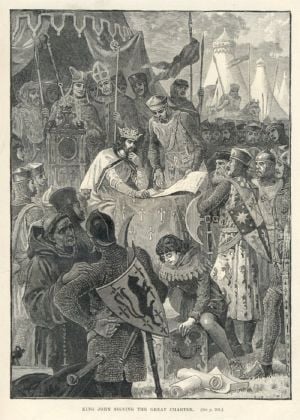
The English Middle Ages, which lasted from 1066 until conflicts over the English throne between the Houses of Lancaster and York, known as the Wars of the Roses, ended in 1487, were characterised by civil war, international war, occasional insurrection, and widespread political intrigue among the aristocratic and monarchic elite. The signing of the Magna Carta in 1215, had lasting impact. King John (1166 – 1216) suffered the loss of Normandy and numerous other French territories following the disastrous Battle of Bouvines in 1214. He managed to antagonise the feudal nobility and leading Church figures to the extent that in 1215, they led an armed rebellion and forced him to sign the Magna Carta, which required the king to renounce certain rights, respect certain legal procedures and accept that "the will of the king could be bound by law." It established that the king may not levy or collect any taxes (except the feudal taxes to which they were hitherto accustomed) without the consent of a council. Magna Carta was the most significant early influence on the long historical process that led to the rule of constitutional law.
The once independent Principality of Wales fell under the control of English monarchs from the Statute of Rhuddlan in 1284.
Wycliffe and the Lollards
John Wycliffe (c.1320 – 1384), an English theologian and early proponent of reform in the Roman Catholic Church, worked tirelessly on an English translation of the Bible in one complete edition and is considered a precursor of the Protestant Reformation. Since his beliefs and teachings seemed to compare closely with Luther, Calvin, and other reformers, historians have called Wycliffe "The Morning Star of the Reformation." The itinerant preachers, called Lollards, Wycliffe sent throughout England, created a spiritual revolution. Intense persecution, from both the religious and secular authorities, cracked down on the Lollards sending the movement underground. John Wycliffe denied the doctrine of transubstantiation, which holds that the bread and wine used in the Eucharist changes in substance into the body and blood of Jesus. He was condemned in a Papal Bull in 1410, and all his books were burned. The seeds of reform that Wycliffe planted were not to blossom until a couple hundred years later.
The Tudors
The relatively unknown Henry Tudor, Henry VII, won the final conflict in the Wars of the Roses, the Battle of Bosworth Field in 1485, where the Yorkist Richard III was killed, thus beginning the Tudor period, which lasted until the death of Queen Elizabeth I in 1603.
King Henry VIII (1491-1547) split with the Roman Catholic Church over a question of his divorce from Catherine of Aragon. Though his religious position was not at all Protestant, the resultant schism ultimately led to England distancing itself almost entirely from Rome. There followed a period of great religious and political upheaval, which led to the English Reformation, the royal expropriation of the monasteries and much of the wealth of the church. The Dissolution of the Monasteries had the effect of giving many of the lower classes (the gentry) a vested interest in the Reformation continuing, for to halt it would be to revive Monasticism and restore lands which were gifted to them during the Dissolution.
Henry VIII had one legitimate child and two illegitimate children who survived him. Edward VI of England was only a boy of 10 when he took the throne in 1547. When Edward VI lay dying of tuberculosis in 1553, Mary I (1516-1558) took the throne amidst popular demonstration in her favour in London. Mary, a devout Catholic, also known as Bloody Mary, tried to reimpose Catholicism, which led to 274 burnings of Protestants, which are recorded especially in John Foxe's Book of Martyrs. She was highly unpopular among her people, and the Spanish party of her husband, Philip II caused much resentment around Court. Mary died at the age of 42, to be succeeded by her half-sister, who became Elizabeth I.
The reign of Elizabeth restored a sort of order to the realm. The religious issue, which had divided the country since Henry VIII, was put to rest by the Elizabethan Religious Settlement, which created the Church of England in much the same form we see it today. The Act of Supremacy of 1559 re-established the English church’s independence from Rome, with Parliament conferring on Elizabeth the title Supreme Governor of the Church of England, while the Act of Uniformity of 1559 set out the form the English church would take, including establishing the Book of Common Prayer, and phrasing the delicate issue of transubstantiation. Much of Elizabeth's success was in balancing the interests of the Puritans (radical Protestants) and "die-hard" Catholics.
The slave trade that established Britain as a major economic power can be attributed to Elizabeth, who granted John Hawkins the permission to commence trading in 1562. The number of Africans transported to England was so great due to the slave trade that by 1596 Elizabeth complained. She tried unsuccessfully to expel them via a Proclamation in 1601.
The Stuarts
Elizabeth died in 1603 without leaving any direct heirs. Her closest male Protestant relative was the King of Scots, James VI, of the House of Stuart, who, following the Union of the Crowns, became King James I of England. King James I & VI as he was styled became the first king of the entire island of Great Britain, though he continued to rule the Kingdom of England and the Kingdom of Scotland separately. A number of assassination attempts were made on James, notably the Main Plot and Bye Plots of 1603, and most famously, on November 5, 1605, the Gunpowder Plot, by a group of Catholic conspirators, led by Guy Fawkes, which was stoked up and served as further fuel for antipathy in England towards the Catholic faith.
British colonies
Plantations in Ireland, from 1608, formed a pattern for establishing colonies, and several people involved in those projects also had a hand in the early colonisation of North America — Humphrey Gilbert, Walter Raleigh, Francis Drake and Ralph Lane. In 1607, England built an establishment in Virginia (Jamestown), in what was to become the United States of America. This was the beginning of English colonisation. Many English settled in North America for religious or economic reasons. While the first party religious pilgrims left for the New World in 1620, in the second half of the seventeenth century, those numbers increased dramatically, as these religious pilgrims sought a land where they could worship freely.
The English merchants holding plantations in the warm southern parts of America then resorted rather quickly to the slavery of Native Americans and imported Africans in order to cultivate their plantations and sell raw material (particularly cotton and tobacco) in Europe. The English merchants involved in colonisation accrued fortunes equal to those of great aristocratic landowners in England, and their money, which fueled the rise of the middle class, permanently altered the balance of political power.
The empire took shape during the early seventeenth century, with the English settlement of the eastern colonies of North America, which would later become the original United States, as well as Canada's Atlantic provinces, and the colonisation of the smaller islands of the Caribbean such as Saint Kitts, Barbados and Jamaica. The sugar-producing colonies of the Caribbean, where slavery became central to the economy, were at first England's most important and lucrative colonies.
Civil war
The English Civil War broke out in 1642, largely as a result of an ongoing series of conflicts between James' son, Charles I, and Parliament. The defeat of the Royalist army by the New Model Army of Parliament at the Battle of Naseby in June 1645 effectively destroyed the king's forces. Charles surrendered to the Scottish army at Newark. He was eventually handed over to the English Parliament in early 1647. He escaped and the Second English Civil War began, although it was to be only a short conflict, with Parliament quickly securing the country. The capture and subsequent trial of Charles led to his beheading in January 1649 at Whitehall Gate in London. A republic was declared and Oliver Cromwell became the Lord Protector in 1653. After he died, his son Richard Cromwell succeeded him in the office, but soon abdicated.
Monarchy restored
The monarchy was restored in 1660, after England entered a period lacking in social standards, with King Charles II returning to London. In 1665, London was swept by a visitation of the plague, and then, in 1666, the capital was swept by the Great Fire, which raged for five days, destroying approximately 15,000 buildings).
Glorious Revolution
The death of Charles II in 1685 meant his Catholic brother was crowned King James II & VII. England with a Catholic King on the throne was too much for both people and parliament and in 1689 the Dutch Protestant Prince William of Orange was invited to replace King James II in what became known as the Glorious Revolution. Despite attempts to secure his reign by force, James was finally defeated by William at the Battle of the Boyne in 1690. On February 13, 1689, Parliament passed the Declaration of Right, in which it deemed that James, by attempting to flee on December 11, 1688, had abdicated the government of the realm, thereby leaving the Throne vacant. William and Mary were crowned together at Westminster Abbey on April 11, 1689.
William III of England encouraged the passage of the Act of Toleration 1689, which guaranteed religious toleration to certain Protestant nonconformists. It did not, however, extend toleration to Roman Catholics or those of non-Christian faiths. Thus the Act was not as wide-ranging as James II's Declaration of Indulgence, which attempted to grant freedom of conscience to people of all faiths.
However, in parts of Scotland and Ireland Catholics loyal to James remained determined to see him restored to the throne and there followed a series of bloody though unsuccessful uprisings. As a result of these, any failure to pledge loyalty to the victorious King William was severely dealt with. The most infamous example of this policy being the Massacre of Glencoe in 1692. Jacobite rebellions continued on into the mid-eighteenth century until the son of the last Catholic claimant to the throne, (James III & VIII), mounted a final campaign in 1745. The Jacobite forces of Prince Charles Edward Stuart, the "Bonnie Prince Charlie" of legend, were resoundly defeated at the Battle of Culloden in 1746.
United Kingdom formed
Under the Acts of Union 1707, England (including Wales) and Scotland, which had been in personal union since the Union of the Crowns in 1603, agreed to a political union in the form of a unified Kingdom of Great Britain. The Act of Union 1800 united the Kingdom of Great Britain with the Kingdom of Ireland, which had been gradually brought under English control between 1541 and 1691, to form the United Kingdom of Great Britain and Ireland in 1801.
Since 1707 England, while ceasing to exist as an independent political entity, has remained highly dominant in what is now the United Kingdom of Great Britain and Northern Ireland. Due to her geographic size and large population, the dominant political and economic influence in the UK stems from England. London has remained the capital city of the UK and has built upon its status as the economic and political centre of the UK. It is also one of the world's great cities.
Enlightenment Britain
Britain was an important part of the Age of Enlightenment with philosophical and scientific input and a literary and theatrical tradition. Over the next century the United Kingdom played an important role in developing Western ideas of parliamentary democracy, partly via the emergence of a multi-party system, as evidenced in the rise of the Whig and Tory political parties. There were significant contributions to literature, the arts and science. But, like other Great Powers, the UK was involved in colonial exploitation, including the infamous slave trade, until the passing of the 1807 Slave Trade Act made the UK the first nation to permanently prohibit trade in slaves.
Confidence in the rule of law, which followed establishment of the prototype of constitutional monarchy in Britain in the Glorious Revolution of 1688, and the emergence of a stable financial market there based on the management of the national debt by the Bank of England, contributed to the capacity for, and interest in, private financial investment in industrial ventures. In addition, Britain had an entrepreneurial class which believed in progress, technology and hard work. This Protestant work ethic has been regarded as one of the cornerstones of national prosperity.
The British Empire
After the defeat of Napoleon Bonaparte (1769-1821) in the Napoleonic Wars (1804-1815), Britain became the principal naval power of the nineteenth century. At its peak, the British Empire was the largest empire in history and for a substantial time was the foremost global power.
The Industrial Revolution
The UK led the Industrial Revolution, a period in the late eighteenth and early nineteenth centuries when technological advances and mechanisation transformed a largely agrarian society throughout Europe, causing considerable social upheaval. Much of the agricultural workforce was uprooted from the countryside and moved into large urban centres of production, as the steam-based production factories could undercut traditional cottage industries. The consequent overcrowding into areas with little supporting infrastructure saw dramatic increases in the rise of infant mortality (to the extent that many Sunday schools for pre-working age children (five or six) had funeral clubs to pay for each other's funeral arrangements), crime, and social deprivation. Many workers saw their livelihoods threatened by the process, and some frequently sabotaged or attempted to sabotage factories. These saboteurs were known as Luddites.
Chartism
During the early nineteenth century, the working classes began to find a voice. Concentrations of industry led to the formation of guilds and unions, which, although at first suppressed, eventually became powerful enough to resist government policy. Chartism is thought to have originated from the passing of the 1832 Reform Bill, which gave the vote to the majority of the (male) middle classes, but not to the "working class". Many people made speeches on the "betrayal" of the working class and the "sacrificing" of their "interests" by the "misconduct" of the government. In 1838, six members of Parliament and six workingmen formed a committee, which then published the People's Charter.
But by the end of the Victorian era (1900), the United Kingdom lost its industrial leadership, particularly to the United States, which surpassed the UK in industrial production and trade in the 1890s, as well as to the German Empire.
Victorian England
The Victorian era of the United Kingdom marked the height of the British Industrial Revolution and the apex of the British Empire. Although commonly used to refer to the period of Queen Victoria's rule between 1837 and 1901, scholars debate whether the Victorian period—as defined by a variety of sensibilities and political concerns that have come to be associated with the Victorians—actually begins with the passage of the Reform Act 1832. The era was preceded by the Regency era and succeeded by the Edwardian period
By virtue of Queen Victoria's marriage to Prince Albert, son of Duke Ernst I of the small German duchy of Saxe-Coburg and Gotha, her descendants were members of the ducal family of Saxe-Coburg and Gotha with the house name of Wettin. Victoria's son Edward VII and his son George V reigned as members of this house.
World War I
The First World War was a global military conflict which took place primarily in Europe between 1914 and 1918. More than nine million soldiers and civilians died. The conflict had a decisive impact on the history of the twentieth century. The Entente Powers, led by France, Russia, the United Kingdom, and later Italy (from 1915) and the United States (from 1917), defeated the Central Powers, led by the Austro-Hungarian, German, and Ottoman Empires. Russia withdrew from the war after the revolution in 1917.
High anti-German feeling among the people during World War I prompted the Royal Family to abandon all titles held under the German crown and to change German-sounding titles and house names for English-sounding versions. On July 17, 1917, a royal proclamation by George V provided that all agnatic descendants of Queen Victoria would be members of the House of Windsor with the personal surname of Windsor. The name Windsor has a long association with English royalty through the town of Windsor and Windsor Castle.
After the carnage of the Great War, Britain remained an eminent power, and its empire expanded to its maximum size, gaining the League of Nations mandate over former German and Ottoman colonies after World War I. By 1921, the British Empire held sway over a population of about 458 million people, approximately one-quarter of the world's population. It covered about 14.2 million square miles, about a quarter of Earth's total land area. As a result, its legacy is widespread, in legal and governmental systems, economic practice, militarily, educational systems, sports (such as cricket, rugby and football), and in the global spread of the English language and Anglican Christianity. At the peak of its power, it was often said that "the sun never sets on the British Empire" because its span across the globe ensured that the sun was always shining on at least one of its numerous colonies or subject nations.
Independence for the Irish Free State in 1922 followed the partition of Ireland two years previously, with six of the nine counties of the province of Ulster remaining within the UK, which then changed in 1927 to the name of the United Kingdom of Great Britain and Northern Ireland.
World War II
The Second World War, was a worldwide military conflict which lasted from 1939 to 1945. It was the amalgamation of two conflicts, one beginning in Asia, in 1937, as the Second Sino-Japanese War and the other beginning in Europe, in 1939, with the invasion of Poland. It is regarded as the historical successor to World War I. The majority of the world's nations split into two opposing camps: the Allies and the Axis. The UK fought with its Commonwealth allies including Canada, Australia, New Zealand, South Africa and India, later to be joined by further allies. Spanning much of the globe, World War II resulted in the deaths of over 60 million people, making it the deadliest conflict in human history. The conflict ended in an Allied victory.
Wartime leader Winston Churchill and his successor Clement Atlee helped plan the post-war world as part of the "Big Three". World War II, however, left the United Kingdom financially and physically damaged. Loans taken out during and after World War II from the United States and from Canada were economically costly, but, along with post-war US Marshall aid, they started the UK on the road to recovery. As a result, the United States and Soviet Union emerged as the world's two leading superpowers, setting the stage for the Cold War for the next 45 years. Self determination gave rise to independence movements in Asia and Africa, while Europe itself began traveling the road leading to integration. During the five decades following World War II, most of the territories of the Empire became independent. Many went on to join the Commonwealth of Nations, a free association of independent states.
Multi-ethnic welfare state
The immediate post-war years brought the establishment of the British Welfare State and one of the world's first and most comprehensive Health Services, while the demands of a recovering economy brought people from all over the Commonwealth to create a multi-ethnic UK. Although the new postwar limits of Britain's political role were confirmed by the Suez Crisis of 1956, the international currency of the language meant the continuing impact of its literature and culture, while at the same time from the 1960s its popular culture found an influence abroad.
Following a period of economic stagnation and industrial strife in the 1970s after a global economic downturn, the 1980s saw the inflow of substantial oil revenues, and the premiership of Margaret Thatcher, under whom there was a marked break with the post-war political and economic consensus. Her supporters credit her with economic success, but her critics blame her for greater social division. From the mid-1990s onward these trends largely continued under the leadership of Tony Blair.
The United Kingdom has been a member of the European Union since 1973. The attitude of the present Labour government towards further integration with this organisation has been mixed, and the Liberal Democrats supportive of current engagement.
Government and politics
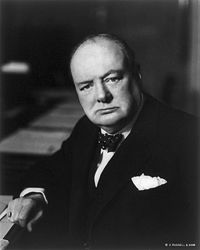
Structure
The United Kingdom is a constitutional monarchy. Hereditary monarch Queen Elizabeth II has been chief of state since February 6, 1952, while the Heir Apparent is Prince Charles, the son of the Queen, born November 14, 1948. Prime Minister Gordon Brown has been head of government since June 27, 2007. After legislative elections, the leader of the majority party or the leader of the majority coalition is usually the prime minister, who appoints a cabinet.
The bicameral parliament consists of a House of Lords, which has 618 seats consisting of approximately 500 life peers, 92 hereditary peers, and 26 clergy, and a House of Commons, which has 646 members elected by popular vote to serve terms of five-years, or less if the House is dissolved earlier. The parliament is traditionally considered to be "supreme" in that it is able to legislate on any matter and not bound by decisions of its predecessors.
In the House of Lords, elections are held only as vacancies in the hereditary peerage arise, whereas in the House of Commons, elections were last held in May 2005. In those elections, Labor took 35.2 percent of the vote, the Conservative took 32.3 percent, Liberal Democrats 22 percent, and others took 10.5 percent. In 1998, elections were held for a Northern Ireland Assembly. Because of unresolved disputes, the transfer of power from London to Northern Ireland came only at the end of 1999 and has been suspended four times, the latest occurring in October 2002 and lasting until May 2007. In 1999, there were elections for a Scottish Parliament and a Welsh Assembly.
The United Kingdom is one of the few countries in the world today that does not have a codified constitution, relying instead on traditional customs and separate pieces of constitutional law. The British system of government has been emulated around the world — a legacy of the British Empire's colonial past — most notably in the other Commonwealth Realms.
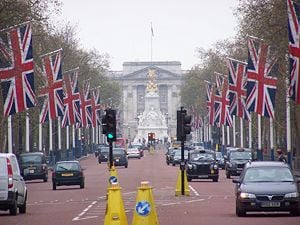
In the United Kingdom, the monarch has extensive theoretical powers, but his/her role is mainly, though not exclusively, ceremonial. The monarch is an integral part of Parliament (as the "Crown-in-Parliament") and theoretically gives Parliament the power to meet and create legislation. An Act of Parliament does not become law until it has been signed by the monarch (known as Royal Assent), although not one has refused assent to a bill that has been approved by Parliament since Queen Anne in 1708. Although the abolition of the monarchy has been suggested, the popularity of the monarchy remains strong in the United Kingdom. Support for a British republic usually fluctuates between 15 percent and 25 percent of the population, with roughly 10 percent undecided or indifferent.
Since the 1920s, the two largest political parties in British politics have been the Labour Party and Conservative Party. Though coalition and minority governments have been an occasional feature of Parliamentary politics, the first-past-the-post electoral system tends to maintain the dominance of these two parties, though each has in the past century relied upon a third party to deliver a working majority. The Liberal Democrats, the third largest party, seek a reform to address the dominance of the two-party system.
Though many in the United Kingdom consider themselves "British" as well as "English", "Scottish", "Welsh", or "Irish" (and increasingly also "Afro-Caribbean", "Indian", or "Pakistani"), there has long been a widespread sense of separate national identities in the nations of Scotland and Wales, and among the Catholic community in Northern Ireland. Independence for the Republic of Ireland in 1922 provided only a partial solution to what had been termed in the nineteenth century the "Irish Question", and competing demands for a united Ireland or continued union with Great Britain have brought civil strife and political instability up to the present day.
Though "nationalist" (as opposed to "unionist") tendencies have shifted over time in Scotland and Wales, with the Scottish National Party founded in 1934 and Plaid Cymru (the Party of Wales) in 1925, a serious political crisis threatening the integrity of the United Kingdom has not occurred since the 1970s. Scotland, Wales, and Northern Ireland each possess a legislature and government alongside that of the United Kingdom. However, this increased autonomy and devolution of executive and legislative powers has not contributed to a reduction in support for independence from the United Kingdom, with the rise of new pro-independence parties.
The resurgence in the Celtic language and identity, as well as "regional" politics and development, has contributed to forces pulling against the unity of the state. In Northern Ireland, there has been a significant decrease in violence over the last 20 years, though the situation remains tense, with the more hardline parties, such as Sinn Féin and the Democratic Unionists, now holding the most parliamentary seats.
The United Kingdom has three distinct systems of law. English law, which applies in England and Wales, and Northern Ireland law, which applies in Northern Ireland, are based on common-law principles. Scots law, which applies in Scotland, is a hybrid system based on both common-law and civil-law principles. The Act of Union 1707 guarantees the continued existence of a separate law system for Scotland.
The Appellate Committee of the House of Lords is the highest court in the land for all criminal and civil cases in England, Wales, and Northern Ireland, and for all civil cases in Scots law. Recent constitutional changes will see the powers of the House of Lords transfer to a new Supreme Court of the United Kingdom.
In England and Wales, the court system is headed by the Supreme Court of Judicature of England and Wales, consisting of the Court of Appeal, the High Court of Justice (for civil cases) and the Crown Court (for criminal cases). In Scotland, the chief courts are the Court of Session, for civil cases, and the High Court of Justiciary, for criminal cases, while the sheriff court is the Scottish equivalent of the county court. The Judicial Committee of the Privy Council is the highest court of appeal for several independent Commonwealth countries, the UK overseas territories, and the British crown dependencies.
Administrative subdivisions
The United Kingdom is divided into four parts, commonly referred to as the constituent countries. Each nation is further subdivided for the purposes of local government. The Queen appoints a Lord-Lieutenant as her personal representative in lieutenancy areas across the UK, which is little more than a ceremonial role.
Historically, the four nations were divided into counties as areas for local government administration. Although these are still used to some extent for this purpose and as geographical areas, they are no longer the sole basis for local government administration.
England has been divided into nine intermediate-level Government Office Regions. Each region is made up of counties and unitary authorities, apart from London, which consists of London boroughs. City status is governed by Royal Charter. In 2007, there were 66 British cities (50 in England, six in Scotland, five in Wales, and five in Northern Ireland).
The British crown has sovereignty over the Bailiwicks of Jersey and Guernsey, and the Isle of Man, known collectively as the crown dependencies. These are lands owned by the British monarch, but are not part of the United Kingdom, and are not in the European Union. However, the Parliament of the United Kingdom has the authority to legislate for the dependencies, and the British government manages their foreign affairs and defence.
The UK also has 14 overseas territories around the world, the last remaining territories of the British Empire. The overseas territories are not considered part of the UK, but in some cases the local populations have British citizenship and the right to live in the UK.
Military
The armed forces of the United Kingdom are known as Her Majesty's Armed Forces. Their Commander-in-Chief is the British monarch, they are managed by the Ministry of Defence, and are controlled by the Defence Council.
The United Kingdom fields one of the most powerful and comprehensive armed forces in the world. It has significant global capabilities, with total allied naval tonnage second only to the United States military and the third largest share of tactical combat aircraft to the US and France. The UK has the second or third highest military expenditure in the world, after the United States and China. The United Kingdom possesses a comprehensive nuclear arsenal, one of the small number of countries to do so, utilising the submarine-based Trident II ballistic missile system with nuclear warheads.
The British Armed Forces are active participants in the North Atlantic Treaty Organisation (NATO) and other coalition operations.
The British Army had a reported strength of 102,440 in 2005, and the Royal Air Force a strength of 49,210. The 36,320-member Royal Navy operates the United Kingdom's nuclear deterrent, which consists of four Trident missile-armed submarines, while the Royal Marines are the Royal Navy's Light Infantry units for amphibious operations and for specialist reinforcement forces in and beyond the NATO area. This puts total active duty military troops in the 190,000 range, currently deployed in over 80 countries.
There are also reserve forces supporting the regular military. These include an army reserve, the Territorial Army (TA); the Royal Naval Reserve (RNR), Royal Marines Reserve (RMR) and the Royal Auxiliary Air Force (RAuxAF). About 9 percent of the regular armed forces is made up of women, with more in the reserve forces.
The United Kingdom Special Forces, principally the Special Air Service (SAS) and Special Boat Service (SBS), but including others, provide troops trained for quick, mobile, military responses in counter-terrorism, land, maritime and amphibious operations, often where secrecy or covert operations are required. The last war in which the British military fought alone was the Falklands War of 1982, with full-scale combat operations lasting almost three months.
Foreign relations
The United Kingdom is a permanent member of the United Nations Security Council. It is also a large member state of the European Union, and is one of the three "big powers" along with Germany and France. The United Kingdom also has close relations with the United States, the Special Relationship. Britain's close allies outside of Europe include members of the Anglosphere and Commonwealth of Nations, a legacy of the British Empire. With its membership of the G8 and NATO, Britain has a certain influence in international institutions. Britain's global presence is amplified further through its trading relations and its armed forces, which maintains approximately 80 military installations and other deployments around the globe
Economy
The British economy is the home of the Anglo-Saxon economic model, focusing on the principles of liberalisation, the free market, "common law" relating to property, and low taxation and regulation. Based on market exchange rates, the United Kingdom is the fifth largest economy in the world; the second largest in Europe after Germany, and the sixth-largest overall by purchasing power parity (PPP) exchange rates.
The British were the first in the world to enter the Industrial Revolution, and, like most industrialising countries at the time, initially concentrated on heavy industries such as shipbuilding, coal mining, steel production, and textiles. The empire created an overseas market for British products, allowing the United Kingdom to dominate international trade in the nineteenth century. However, as other nations industrialised and surplus labour from agriculture began to dry up, the United Kingdom started to lose its economic advantage. As a result, heavy industry declined throughout the twentieth century. The British service sector, however, has grown substantially, and now makes up about 73 percent of GDP.
In the 1980s, under the Government of Margaret Thatcher, most state-owned enterprises in the industrial and service sectors, which since the 1940s had been nationalised, were privatised. The British Government now owns very few industries/businesses apart from the Post Office and a few others.
The British economy, by the beginning of the twenty first century, has gone through the longest period of sustained economic growth for more than 150 years, and is one of the strongest European Union economies in terms of inflation, interest rates and unemployment, all of which remain relatively low. However, in common with the economies of other English-speaking countries, it has higher levels of income inequality than some European countries.
The service sector of the United Kingdom is dominated by financial services, especially in banking and insurance. London is one of the world's largest financial centres with the London Stock Exchange, the London International Financial Futures and Options Exchange, and the Lloyd's of London insurance market all based in the city. It also has the largest concentration of foreign bank branches in the world. In the past decade, a rival financial centre in London has grown in the Docklands area, with HSBC, Citigroup, and Barclays Bank all relocating their head offices there. The Scottish capital, Edinburgh also has one of the large financial centres of Europe
Tourism is very important to the British economy. With over 27 million tourists a year, the United Kingdom is ranked as the sixth major tourist destination in the world.
The British manufacturing sector, however, has greatly diminished since World War II. It is still a significant part of the economy, but only accounted for one-sixth of national output in 2003. The British motor industry is a significant part of this sector, although all large-volume producers are now foreign-owned. Civil and defence aircraft production is led by the United Kingdom's largest aerospace firm, BAE Systems, and the pan-European consortium known as Airbus. Rolls-Royce holds a major share of the global aerospace engines market. The chemical and pharmaceutical industry is also strong in the UK, with the world's second and third largest pharmaceutical firms (GlaxoSmithKline and AstraZeneca, respectively) being based in the UK.
The United Kingdom's agriculture sector is small by European standards, accounting for only 0.9 percent of GDP. The UK though has large coal, natural gas, and oil reserves. Primary energy production accounts for about 10 percent of Gross domestic product (GDP), one of the highest shares of any industrial state.
The currency of the UK is pound sterling, represented by the symbol £. The Bank of England is the central bank and is responsible for issuing currency, although banks in Scotland and Northern Ireland retain the right to issue their own notes, subject to retaining enough Bank of England notes in reserve to cover the issue. The UK chose not to join the Euro on the currency's launch, although the government has pledged to hold a public referendum for deciding membership if "five economic tests" are met.
Government involvement over the economy is exercised by the Chancellor of the Exchequer who heads HM Treasury, but the Prime Minister, is First Lord of the Treasury (the Chancellor of the Exchequer being the Second Lord of the Treasury). However since 1997, the Bank of England has control of interest rates and other monetary policy. The UK government has greatly increased public sector spending (i.e.: government spending of taxes) since 1995, and annual spending on investment in infrastructure has grown from £5.6-billion in 1997 to £29-billion in 2006.
The government's Department for Transport oversees the well-developed transport system in the United Kingdom. A radial road network of 29145 miles of main roads is centred on London, Edinburgh and Belfast, while, in Great Britain, a motorway network of 2173 miles is centred on Birmingham and London. There are a further 213750 miles of paved roads.
The National Rail network of 10,072 route miles (16,116 route kilometers) in Great Britain and 189 route miles (303km) in Northern Ireland carries over 18,000 passenger trains and 1000 freight trains daily. Urban rail networks are well developed in London and several other cities. There was once over 30,000 route miles of rail network in the U.K., however most of this was reduced over a time period from 1955 to 1975, much of it after a report by a government advisor Richard Beeching in the mid 1960s (known as the Beeching Axe).
Heathrow Airport is the world's busiest international airport, and being an island nation the UK has a considerable network of sea ports, which received over 558 million tonnes of goods in 2003–04.
Exports totalled $468.8-billion in 2006. Export commodities included manufactured goods, fuels, chemicals, food, beverages, and tobacco. Export partners included the United States 13.9 percent, Germany 10.9 percent, France 10.4 percent, Ireland 7.1 percent, Netherlands 6.3 percent, Belgium 5.2 percent, and Spain 4.5 percent. Imports totalled $603-billion. Import commodities included manufactured goods, machinery, fuels, and foodstuffs. Import partners included Germany 12.8 percent, the United States 8.9 percent, France 6.9 percent, Netherlands 6.6 percent, China 5.3 percent, Norway 4.9 percent, and Belgium 4.5 percent.
Per capita GDP was $30,436, in 2005, a rank of 18th, unemployment was 2.9 percent in 2006, and 17 percent lived below the poverty line in 2002.
Demographics
The United Kingdom's population increased to 60.2 million in 2006, the third-largest in the European Union (behind Germany and France) and the twenty-first largest in the world. The increase resulted from net immigration, and from a rising birth rate and increasing life expectancy — of 78.7 years for the total population in 2007. Its overall population density is one of the highest in the world. About a quarter of the population lives in England's prosperous south-east and is predominantly urban and suburban, with an estimated 7,517,700 in the capital of London.
Ethnicity
Present day Britons are descended mainly from the varied ethnic stocks that settled there before the eleventh century. The pre-Celtic, Celtic, Roman, Anglo-Saxon, and Norse influences were blended on Great Britain under the Normans, Scandinavian Vikings who had lived in Northern France. Between the various constituent countries, there has been sufficient internal migration to mix the population.
Constant waves of immigration hit the UK, with Europe, Africa and South-East Asia being the biggest areas from where people emigrate. In the 2001 Census, 7.9 percent of the UK's population identified themselves as an "ethnic minority". In some UK cities the percentage of "minority groups" is large but is still less than half. For example; Birmingham (UK's second largest city) has 29.6 percent, and Leicester 36 percent. There are a large number of Indians, mainly from northern India, who make up about 2.0 percent of the population.
Ethnicity, as detailed in the 2001 UK Census: White British, 85.67 percent; white (other), 5.27 percent; Indian, 1.8 percent; Pakistani, 1.3 percent; mixed race, 1.2 percent; white Irish, 1.2 percent; black Caribbean, 1.0 percent; black African, 0.8 percent; Bangladeshi, 0.5 percent; Asian (non-Chinese), 0.4 percent; British Chinese, 0.4 percent; other, 0.4 percent; and black (others), 0.2 percent;
Religion
Unlike many countries today, which are officially secular, the UK is an officially Christian country. This is reflected throughout British public life, for instance, there are established state churches in England and Scotland and the Head of State is a Christian monarch crowned by an arch-bishop in a church.
A majority of Britons, 72 percent, identify themselves as Christian, although the United Kingdom has one of the lowest levels of public worship attendance in the world, with less than 8 percent of people attending any form of worship on a regular basis (of whom the majority are of middle-aged and older generations).
Each home nation has its own church hierarchy. The Church of England is the officially established Christian church in England, and acts as the "mother" and senior branch of the worldwide Anglican Communion. Originally established as part of the Roman Catholic Church in 597C.E. by Augustine of Canterbury on behalf of Pope Gregory I, the Church split from Rome in 1534 during the reign of Henry VIII of England. The Church of England is a state church, and some of her bishops sit in the House of Lords. The British monarch is required to be a member of the Church of England under the Act of Settlement 1701 and is the Supreme Governor. Roman Catholics are expressly forbidden from becoming monarch, stemming from conflict over the crown and whether Britain was in the past, Catholic or Protestant. The Church of England is based at Canterbury Cathedral and the Archbishop of Canterbury is the senior clergyman.
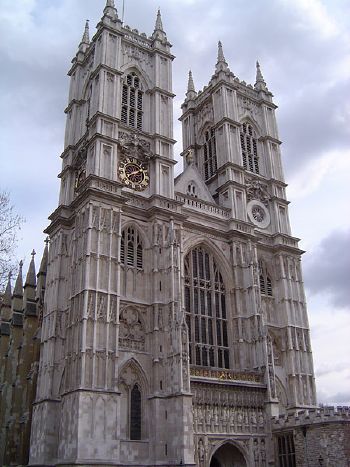
The Church of Scotland (known informally as The Kirk) is the national church of Scotland. It is a Presbyterian church and is not subject to state control. The British monarch is an ordinary member, although the monarch is required to swear an oath to "defend the security" of the Church at their coronation. Splits in the Church since the Reformation have led to the creation of various other Presbyterian churches in Scotland including the Free Church of Scotland and the Free Presbyterian Church of Scotland.
In Wales, the Church in Wales was disestablished in the 1920s, although it remains in the Anglican community. The Church of Ireland was disestablished in the nineteenth century.
The Roman Catholic Church is the second largest denomination in the UK. After the Reformation, strict laws were passed against Catholics; these were removed by the Catholic Emancipation laws in the 1850s. The Catholic hierarchy is separate in England and Wales, Scotland.
In Northern Ireland, the Catholic Church in Ireland is the largest single denomination. The Presbyterian Church in Ireland is the largest Protestant denomination and is in terms of theology and history very closely linked to the Church of Scotland. Other large Christian groups are the Methodists and the Baptists.

Muslims are believed to number over 1.8 million, with many of them living in towns and cities including London, Birmingham, Bradford and Oldham. Mosques are a common sight in some parts of modern day Britain. The biggest groups of British Muslims are of Pakistani, Indian and Bangladeshi origin. More recently, the wave of Somali and Middle-Eastern asylum seekers has increased Britain's Muslim population. The 2006 controversy over the burqa reflects a split between some Britons who are questioning the extent to which Islam is compatible with British society, and others who are happy with the widespread presence of Islam in Britain.
The religions of Indian origin, like Hinduism and Sikhism in Britain are also increasing in number, with over 500,000 Hindus and 320,000 Sikhs in the country. However, these figures are likely to have increased, as they are based on the 2001 census.
Census data regarding religious belief: Christian 71.6 percent, Muslim 2.7 percent, Hindu 1.0 percent, Sikh 0.6 percent, Jewish 0.5 percent, Buddhist 0.3 percent, other religion 0.3 percent, not stated 7.3 percent, no religion 15.5 percent. A total of 76.8 percent of the population adhere to some religion.
Language
While the UK does not have an official language, the predominant spoken language is English. This is a West Germanic language, descended from Old English, which features a large number of borrowings from Norman French. The other main indigenous languages are the the Celtic languages of the British Isles. These fall into two groups: the P-Celtic languages (Welsh and the Cornish language); and the Q-Celtic languages (Irish and Scottish Gaelic).
The English language has spread to all corners of the world (primarily because of the British Empire) and is referred to as a "global language". Worldwide, it is taught as a second language more than any other. The United Kingdom's Celtic languages are also spoken by small groups around the globe, mainly Gaelic in Nova Scotia, Canada, and Welsh in Patagonia, Argentina.
Additional indigenous languages are Scots (which is closely related to English); Romany; and British Sign Language (Northern Ireland Sign Language is also used in Northern Ireland). Celtic dialectal influences from Cumbric persisted in Northern England for many centuries, most famously in a unique set of numbers used for counting sheep.
Immigrants, especially from the Commonwealth, speak many other languages, including Gujarati, Hindi, Punjabi, Urdu, Bengali, Cantonese, Turkish and Polish. The United Kingdom has the largest number of Hindi and Punjabi speakers outside Asia.
Men and women
About half of British women work, and of these, half are part-time workers. The ideal of gender equality is widely shared, but inequality is evident in access to occupations by women and men, pay levels for similar kinds of work, and in the allocation of domestic tasks.
Marriage and the family
Historically most people in the United Kingdom lived either in conjugal extended families or nuclear families. This reflected an economic landscape where the general populace tended to have less spending power, meaning that it was more practical to stick together rather than go their individual ways. This pattern also reflected gender roles. Men were expected to go out to work and women were expected to stay at home and look after the families.
In the twentieth century, the emancipation of women, the greater freedoms enjoyed by both men and women in the years following the Second World War, greater affluence and easier divorce] have changed gender roles and living arrangements significantly. The trend is a rise in single people living alone, the virtual extinction of the extended family (outside certain ethnic minority communities), and the nuclear family reducing in prominence.
From the 1990s, the break-up of the traditional family unit, when combined with a low interest rate environment and other demographic changes, has created great pressure on the housing market, in particular regarding the accommodation of key workers such as nurses, other emergency service workers and teachers, who are priced out of most housing, especially in South East England.
Some research indicates that in the twenty first century, young people are tending to continue to live in the parental home for much longer than their predecessors. The high cost of living, combined with rising cost of accommodation, further education and higher education means that many young people cannot afford to live independent lives from their families.
Premarital sex and unmarried cohabitation are widely accepted. However, single motherhood caused by unstable cohabiting relationships, or marital breakdown, or as a means of obtaining welfare, is seen as a big problem because of its drain on the welfare budget, and subsequent problems of child abuse, and juvenile delinquency, rather than as a moral question.
Education
The United Kingdom's high literacy rate of 99 percent is attributable to universal public education introduced for the primary level in 1870 and secondary level in 1900 (except in Scotland where it was introduced in 1696).
There are separate education systems in England, Northern Ireland, Scotland and Wales. Education (although not necessarily in the form of school attendance) is compulsory for all children between the ages of five and 16, though the UK Government announced in January 2007 plans to change this to five - 18 in England. Most English, Welsh and Northern Irish state (but not independent) schools usher students through nursery school, one of two primary school tracks, and one of two secondary tracks, of which sixth form is optional. About one-fifth of British students go on to post-secondary education (18+). Most children and young people in the UK are educated in state-funded schools financed through the tax system and so parents do not pay directly for the cost of education.
Education in England, Wales and Northern Ireland follows the national curriculum, which was introduced in 1988, which includes the core subjects English, mathematics, and science and the foundation subjects: design and technology, information and communication technology (known as ICT), history, geography, modern foreign languages (MFL), music, art and design and the subjects of the basic curriculum, physical education, citizenship education plus compulsory religious education (RE) which has a unique place in British law. Welsh is also a core subject in Wales. Scottish Gaelic may be taught to some pupils in Scotland.
The Scottish curriculum has emphasised breadth across a range of subjects, while the English, Welsh and Northern Irish system has emphasised greater depth of education over a smaller range of subjects at secondary school level.
The United Kingdom contains some of the world's leading, and oldest, seats of higher education, such as the ancient multifaculty universities at Oxford and Cambridge. It has produced many great scholars, scientists and engineers including Sir Isaac Newton, Adam Smith, Kelvin, Sir Humphry Davy, Joseph John Thomson, Michael Faraday, Charles Darwin, Alexander Fleming, Francis Crick, Sir Joseph William Bazalgette and Isambard Kingdom Brunel. The nation is credited with numerous scientific discoveries including hydrogen, gravity, the electron, structure of DNA, antibiotics and inventions including the chronometer, steam locomotive and the modern railway, vaccination, television, electric lighting, the electric motor, the screw propeller, the internal combustion engine, the jet engine, the modern bicycle, the electronic computer, along with the later development of the World Wide Web.
In 2006, it was reported that the UK was the most productive source of research after the United States; with the UK producing 9 percent of the world's scientific research papers with a 12 percent share of citations.
Class
Traditionally, British society has been stratified into three classes, with the highest occupied by the aristocratic inheritors of old, landed wealth. Those in the working class typically grow up in a family supported by wages earned in industrial or agricultural labor. Neither parent has university education, and the family home is rented. The working class supports the trade union movement and the Labor Party. A middle-class person has parents with white-collar jobs who are likely to have higher education, and own their suburban house. Education is seen as the key to advancement. They tend to support the Conservative Party, which stresses self-sufficiency and individualism. However, de-industrialization, increased social mobility, and the emergence of the knowledge economy have re-defined notions of class, so that numerous educated middle class people vote for the Labor Party.
Culture
Architecture
The earliest remnants of architecture in the United Kingdom are mainly Neolithic monuments such as Stonehenge and Avebury, and Roman ruins such as the spa in Bath. Many castles remain from the medieval period and in most towns and villages the parish church is an indication of the age of the settlement, built as they were from stone rather than the traditional wattle and daub.
Over the two centuries following the Norman conquest of 1066, and the building of the Tower of London], many great castles such as Caernarfon Castle in Wales and Carrickfergus Castle in Ireland were built to suppress the natives. Large houses continued to be fortified until the Tudor period, when the first of the large gracious unfortified mansions such as the Elizabethan Montacute House and Hatfield House were built.
The English Civil War (1642—1649) proved to be the last time in British history that houses had to survive a siege. Corfe Castle was destroyed following an attack by Oliver Cromwell's army, but Compton Wynyates survived a similar ordeal. After this date houses were built purely for living, and design and appearance were for ever more important than defence.
Just prior to the Civil War, Inigo Jones, who is regarded as the first significant British architect, came to prominence. He was responsible for importing the Palladian manner of architecture to Britain from Italy; the Queen's House at Greenwich is perhaps his best surviving work.
Following the restoration of the monarchy in 1660 and the Great Fire of London in 1666 an opportunity was missed in London to create a new metropolitan city, featuring modern architectural styles. Although one of the best-known British architects, Sir Christopher Wren, was employed to design and rebuild many of the ruined ancient churches of London, his master plan for rebuilding London as a whole was rejected. It was in this period that he designed the building that he is perhaps best known for, St Paul's Cathedral.
In the early eighteenth century baroque architecture —popular in Europe — was introduced, and Blenheim Palace was built in this era. However, baroque was quickly replaced by a return of the Palladian form. The Georgian architecture of the eighteenth century was an evolved form of Palladianism. Many existing buildings such as Woburn Abbey and Kedleston Hall are in this style. Among the many architects of this form of architecture and its successors, neoclassicism and Romanticism, were Robert Adam, Sir William Chambers, and James Wyatt.
In the early nineteenth century the romantic medieval gothic style appeared as a backlash to the symmetry of Palladianism, and such buildings as Fonthill Abbey were built. By the middle of the nineteenth century, as a result of new technology, construction was able to develop incorporating steel as a building component; one of the greatest exponents of this was Joseph Paxton, architect of the Crystal Palace. Paxton also continued to build such houses as Mentmore Towers, in the still popular retrospective English Renaissance styles. In this era of prosperity and development British architecture embraced many new methods of construction, but ironically in style, such architects as August Pugin ensured it remained firmly in the past.
At the beginning of the twentieth century a new form of design — arts and crafts — became popular. The architectural form of this style, which had evolved from the nineteenth century designs of such architects as George Devey, was championed by Edwin Lutyens. Arts and crafts in architecture is symbolized by an informal, non-symmetrical form, often with mullioned or lattice windows, multiple gables and tall chimneys. This style continued to evolve until World War II.
Following the Second World War reconstruction went through a variety of phases, but was heavily influenced by Modernism, especially from the late 1950s to the early 1970s. Many bleak town centre redevelopments—criticised for featuring hostile, concrete-lined "windswept plazas"—were the fruit of this interest, as were many equally bleak public buildings, such as the Hayward Gallery. Many Modernist-inspired town centres are today in the process of being redeveloped.
In the immediate post-war years, perhaps hundreds of thousands of council houses in vernacular style were built, giving working class people their first experience of private gardens and indoor sanitation.
Modernism remains a significant force in UK architecture, although its influence is felt predominantly in commercial buildings. The two most prominent proponents are Lord Rogers of Riverside and Lord Foster of Thames Bank. Rogers' iconic London buildings are probably Lloyd's Building and the Millennium Dome, while Foster created the Swiss Re Buildings (aka The Gherkin) and the City Hall (London).
The United Kingdom has one of the highest population densities in Europe. Housing tends to be smaller and more closely packed than in other countries, particularly compared to North America. The British have a particular affinity with the terraced house, dating back to the aftermath of the Great Fire of London. The majority of surviving housing built before 1914 is of this type, and consequently it dominates inner residential areas. In the twentieth century the process of suburbanisation led to a spread of semi-detached and detached housing. In the aftermath of the Second World War, public housing was dramatically expanded to create a large number of council estates, although the majority of these have since been purchased by their tenants. Although many British people live in apartments, it is commonly argued that they are less comfortable with this form of living than their European counterparts. This is not the case in Scotland, where many more people live in this type of housing.
Art
The oldest art in the United Kingdom can be dated to the Neolithic period, and is found in a funerary context. But it is in the Bronze age that the first innovative artworks are found. The Beaker people, who arrived in Britain around 2500 B.C.E., were skilled in metal refining, working at first in copper, but later bronze and gold. The Wessex culture excelled in the making of gold ornaments. Works of art placed in graves or sacrificial pits have survived.
In the Iron Age, the Celts made gold ornaments, but stone and most likely wood was also used. This style continued into the Roman period, and would find a renaissance in the Medieval period. It also survived in the Celtic areas not occupied by the Romans, largely corresponding to the present-day Wales and Scotland.
The Romans, arriving in the first century B.C.E., brought with them the Classical style. Funerary monuments, statues and busts have survived. They also brought glasswork and mosaics. Christian art from the fourth century, has been preserved in mosaics with Christian symbols and pictures. Celtic and Scandinavian art have in common the use of intricate, intertwined patterns of decoration.

Anglo-Saxon sculpting was outstanding for its time in the eleventh century, as proved by pre-Norman ivory carvings. Celtic high crosses show the use of Celtic patterns in Christian art. Scenes from the Bible were depicted, framed with the ancient patterns. Some ancient symbols were redefined. Murals were painted on the white-chalked walls of stone churches, and stained glass was used in church and other windows.
As a reaction to abstract expressionism, pop art emerged originally in England at the end of the 1950s.
Notable visual artists from the United Kingdom include John Constable, Sir Joshua Reynolds, Thomas Gainsborough, William Blake and J.M.W. Turner. Twentieth century artists included Francis Bacon, David Hockney, Bridget Riley, and the pop artists Richard Hamilton and Peter Blake. New York-born Sir Jacob Epstein was a pioneer of modern sculpture. More recently, the so-called Young British Artists have gained some notoriety, particularly Damien Hirst and Tracey Emin. Notable illustrators include Aubrey Beardsley, Roger Hargreaves, and Beatrix Potter.
Cinema
The United Kingdom has been influential in the technological, commercial, and artistic development of cinema and probably second only to the USA in producing the greatest quantity of world-wide film stars. Despite a history of successful productions, the industry is characterised by an ongoing debate about its identity (including economic and cultural issues) and the influences of American and European cinema, although it is fair to say a brief "golden age" was enjoyed in the 1940s from the studios of J. Arthur Rank and Korda.
Modern cinema is generally regarded as descending from the work of the French Lumière brothers in 1892, and their show first came to London in 1896. However, the first moving pictures developed on celluloid film were made in Hyde Park, London in 1889 by William Friese Greene, a British inventor, who patented the process in 1890. The film is the first known instance of a projected moving image. The first people to build and run a working 35 mm camera in Britain were Robert W. Paul and Birt Acres. They made the first British film Incident at Clovelly Cottage in February 1895, shortly before falling out over the camera's patent.
The industry in Britain experienced a boom as it first developed in the 1910s, but during the 1920s experienced a recession caused by US competition and commercial practices. The Cinematograph Films Act 1927 introduced protective measures, leading to recovery and an all-time production high of 192 films in 1936. However, over-expansion caused a major crash, and low production continued throughout World War II.
Film production recovered after the war, with a long period of relative stability and growing American investment. But another recession hit the industry in the mid-1970s, reaching an all-time low of 24 films in 1981. Low production continued throughout the 1980s, but it increased again in the 1990s with renewed private and public investment. Although production levels give an overview, the history of British cinema is complex, with various cultural movements developing independently. Some of the most successful films were made during recessions, such as Chariots of Fire (1981).
Clothing
There is no specifically British national costume. Even individually, England, Wales and Northern Ireland have only vestiges of a national costume; Scotland has the kilt and Tam o'shanter (hat). In England, certain military uniforms such as the Beefeater or the Queen's Guard are considered to be symbolic of Englishness, though they are not official national costumes. Morris dancers or the costumes for the traditional English May dance are cited by some as examples of traditional English costume.
This is in large part due to the critical role that British sensibilities have played in world clothing since the eighteenth century. Particularly during the Victorian era, British fashions defined acceptable dress for men of business. Key figures such as Beau Brummell, the future Edward VII and Edward VIII created the modern suit and cemented its dominance. As such, it could be argued that the national costume of the British male is a three-piece suit, necktie and bowler hat - an image regularly used by cartoonists as a caricature of Britishness.
Cuisine
Although there is ample evidence of a rich and varied approach to cuisine during earlier historical periods (particularly so among wealthy citizens), during much of the nineteenth and twentieth century Britain had a reputation for somewhat conservative cuisine. The stereotype of the native cuisine was of a diet progressing little beyond stodgy meals consisting of "meat and two veg". Even today, in more conservative areas of the country, "meat and veg" cuisine is still the favoured choice at the dinner table.
Traditional British fare usually includes dishes such as fish and chips; roast dishes of beef, lamb, chicken and pork; both sweet and savoury pies and puddings, as well as regional dishes such as the Cornish pasty and Lancashire Hotpot.
On January 8, 1940, four months after the outbreak of World War II, a system of food rationing was introduced to conserve stocks and feed the nation during the critical war years. Rationing persisted until July 4, 1954, when a 14-year period of relative privation (which profoundly affected a generation of people attitude to "a culture of food") finally came to an end. With the end of rationing, Britain's diet began to change, slowly at first during the 1950s and 1960s under the influence of such people as Elizabeth David, but immeasurably by the closing decades of the twentieth century.
During the transitional period of the 1970s, a number of influential figures such as Delia Smith (perhaps Britain's most famous homegrown exponent of good food), began the drive to encourage greater experimentation with the new ingredients (e.g. pasta) increasingly being offered by the supermarkets. The evolution of the British diet was further accelerated with the increasing tendency of the British to travel to continental Europe (and sometimes beyond) for their annual holidays, experiencing new and unfamiliar dishes as they travelled to countries such as France, Italy, and Spain.
Towards the mid to late 1990s and onwards an explosion of talented new TV chefs began to come to prominence, (with figures as diverse as Jamie Oliver, Ainsley Harriott, Ken Hom, Nigella Lawson, Madhur Jaffrey, Nigel Slater, James Martin and Keith Floyd) this brought about an increase in the diversity of cuisine people were prepared to try and their confidence in preparing food that had would once have been considered staples of the Mediterranean European, South and East Asian diets. As a result, a new style of cooking called Modern British emerged.
This process of increased variety and experimentation in food inevitably dovetailed with the impact that the post-war influx of immigrants to the UK (many from Britain's former colonies in the Caribbean and Indian sub-continent) had on the national cuisine. The new communities propelled new and exciting dishes and ingredients onto restaurant tables and into the national consciousness. In many instances, British tastes fused with the new dishes to produce entirely new dishes such as the Balti, an English invention based on Indian cuisine that has since gained popularity across the world. Many of these new dishes have since become deeply embedded in the native culture, culminating in a speech in 2001 by Foreign Secretary, Robin Cook, in which he described Chicken Tikka Masala as "a true British national dish."
Literature
Early English writers include Geoffrey Chaucer, Thomas Malory and Geoffrey of Monmouth. These romantic writers were followed by a wave of more realistic writers in later centuries, including Jane Austen (often credited with inventing the modern novel), Charles Dickens, the Brontë sisters, Thomas Hardy, Joseph Conrad, Sir Arthur Conan Doyle and H. G. Wells. In the twentieth century, Virginia Woolf, D. H. Lawrence, J. R. R. Tolkien, George Orwell, Graham Greene and Ian McEwan all excelled. Tolkien became one of the most popular writers of the modern world, returning to a Romantic view of fiction. Children's author J. K. Rowling has had huge success.
In the early medieval period, Welsh writers composed the famous Mabinogion. In modern times, the poets R.S. Thomas and Dylan Thomas brought Welsh culture and ideas to a world audience. In Romantic literature, Scotland offers Sir Walter Scott and Robert Louis Stevenson's epic adventures, and the leading poet of his day, Robert Burns. Modern Scottish writers like Hugh MacDiarmid and Neil M. Gunn helped develop a distinct modernist and nationalist Scottish voice, sometimes termed the Scottish Renaissance. A more grim outlook is found in Ian Rankin's detective stories set in Edinburgh.
Authors of other nationalities, particularly the Irish, and from Commonwealth countries, include Jonathon Swift, Oscar Wilde, Bram Stoker, George Bernard Shaw, Joseph Conrad and Salman Rushdie. Kazuo Ishiguro wrote from the viewpoint of a Japanese author working in the United Kingdom on British themes such as social class.
Important poets include John Milton, William Blake, Robert Burns, William Wordsworth, Lord Byron, John Keats, Alfred, Lord Tennyson, T. S. Eliot, R. S. Thomas, Wilfred Owen, John Betjeman, Philip Larkin, W. H. Auden and Ted Hughes.
Media
The UK has a virtually unrivalled number of media outlets, and the prominence of the English language gives it a widespread international dimension.
The BBC is the UK's publicly-funded radio and television broadcasting corporation, and is the oldest broadcaster in the world. Funded by a compulsory television licence, the BBC operates several television networks and BBC Radio stations both in the UK and abroad. The BBC's international television news service, BBC World, is broadcast throughout the world and the BBC World Service radio network is broadcast in 33 languages globally. Most digital cable television services are provided by NTL:Telewest, and free-to-air digital terrestrial television by Freeview.
The most popular radio station, by number of listeners, is BBC Radio 2, closely followed by BBC Radio 1. There are hundreds of commercial radio stations which are largely local-based offering up a variety of music or talk formats.
Traditionally British newspapers could be split into "quality", serious-minded newspapers (usually referred to as broadsheets because of their large size) and tabloid, popular newspapers. However, because of considerations of convenience of reading, many traditional broadsheets have both switched to a compact-sized format, traditionally used by tabloids. ''The Sun'' has the highest circulation of any daily newspaper in the UK, with approximately a quarter of the market; its sister paper, The News of The World similarly leads the Sunday newspaper market, and traditionally focuses on celebrity-led stories. The Daily Telegraph, a right-of-centre paper, is the highest selling of the qualities (former broadsheets), having overtaken The Times in circulation figures. The Guardian is a more liberal or left-wing former broadsheet. The Financial Times is the main business paper, printed on distinctive salmon-pink broadsheet paper.
Music
Notable composers from the United Kingdom have included Henry Purcell, Sir Edward Elgar, Sir Arthur Sullivan (most famous for working with librettist Sir W. S. Gilbert), Ralph Vaughan Williams, and Lord Benjamin Britten who pioneered British opera.
The UK was, with the US, one of the two main contributors in the development of rock and roll, and the UK has provided some of the world's most famous rock bands including The Beatles, Led Zeppelin, Queen, Deep Purple, The Who, Pink Floyd, Black Sabbath and The Rolling Stones. The UK was at the forefront of punk rock with bands like The Sex Pistols and The Clash, music in the 1970s as well as the creation of heavy metal music along with being the birthplace of the Goth youth culture.
The late-1970s and 1980s saw the rise of Post-Punk and New Wave. The so-called "Second British Invasion" into the US popular music scene took place from 1982 to 1984 when UK bands flooded the US Billboard charts. In the mid to late-1990s, the Britpop phenomenon saw bands such as Radiohead, Oasis and Blur attain considerable national and international success. The 1990s also saw the rise of major Welsh bands such as The Stereophonics and Manic Street Preachers.
The UK is also at the forefront of electronica, with British artists such as The Prodigy and The Chemical Brothers helping this mainly underground genre to cross over into the mainstream (having originated in the early-90's with techno bands such as Orbital).
Also British pop producers Stock Aitken Waterman - dominated the charts in the late-80s and early-90s with their instantly recognisable brand of pop from acts including pop superstar, Kylie Minogue. The 1990s charts were also dominated by the boy band phenomenon, with groups such as Take That thriving amongst countless others. Girl groups like the Spice Girls and Girls Aloud also found considerable success. UK Garage developed out of the urban music scene towards the end of the decade, through popular acts such as the Artful Dodger. The popularity of soft rock bands such as Coldplay has increased, whilst indie music has grown in profile, with Arctic Monkeys enjoying chart success and Pete Doherty gaining newspaper headlines. 'Reality-TV' has produced a new generation of popstars.
Theatre
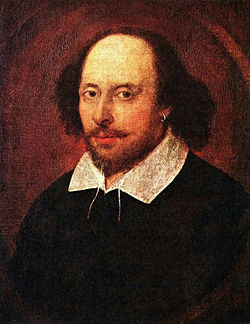
Theatre was introduced to the UK from Europe by the Romans who built auditoriums across the country. By the medieval period theatre had developed with the mummers' plays, a form of early street theatre associated with the Morris dance, concentrating on themes such as Saint George and the Dragon, and Robin Hood. These were folk tales re-telling old stories, and the actors travelled from town to town performing for their audiences in return for money and hospitality. The medieval mystery plays and morality plays, which dealt with Christian themes, were performed at religious festivals.
The reign of Elizabeth I in the late sixteenth century and early seventeenth century saw a flowering of the drama and all the arts. Perhaps the most famous playwright in the world, William Shakespeare, wrote around 40 plays that are still performed in theatres across the world to this day. They include tragedies, such as Hamlet (1603), Othello (1604), and King Lear (1605); comedies, such as A Midsummer Night's Dream (1594—1596) and Twelfth Night (1602); and history plays, such as Henry IV, part 1—2. The Elizabethan age is sometimes nicknamed "the age of Shakespeare" for the amount of influence he held over the era. Other important Elizabethan and seventeenth-century playwrights include Ben Jonson, Christopher Marlowe, and John Webster.
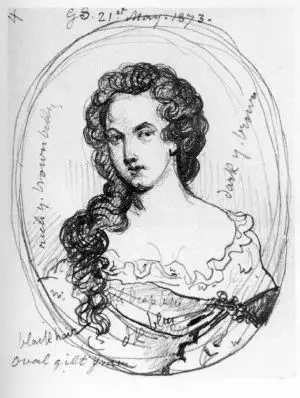
During the Interregnum (1642—1660), English theatres were kept closed by the Puritans for religious and ideological reasons. When the London theatres opened again with the Restoration of the monarchy in 1660, they flourished under the personal interest and support of Charles II. Wide and socially mixed audiences were attracted by topical writing and by the introduction of the first professional actresses (in Shakespeare's time, all female roles had been played by boys). New genres of the Restoration were heroic drama, pathetic drama, and Restoration comedy. The Restoration plays that have best retained the interest of producers and audiences today are the comedies, such as William Wycherley's The Country Wife (1676), The Rover (1677) by the first professional woman playwright, Aphra Behn, John Vanbrugh's The Relapse (1696), and William Congreve's The Way of the World (1700). Restoration comedy is famous or notorious for its sexual explicitness, a quality encouraged by Charles II (1660–1685) personally and by the rakish aristocratic ethos of his court.
In the eighteenth century, the highbrow and provocative Restoration comedy lost favour, to be replaced by sentimental comedy, domestic tragedy such as George Lillo's The London Merchant (1731), and by an overwhelming interest in Italian opera. Popular entertainment became more important in this period than ever before, with fair-booth burlesque and mixed forms that are the ancestors of the English music hall. These forms flourished at the expense of legitimate English drama, which went into a long period of decline. By the early nineteenth century it was no longer represented by stage plays at all, but by the closet drama, plays written to be privately read in a "closet" (a small domestic room).
A change came in the late nineteenth century with the plays on the London stage by the Irishmen George Bernard Shaw and Oscar Wilde and the Norwegian Henrik Ibsen, all of whom influenced domestic English drama and revitalised it.
The West End of London has a large number of theatres, particularly centred around Shaftesbury Avenue. A prolific composer of the twentieth century, Andrew Lloyd Webber, has dominated the West End for a number of years and his musicals have travelled to Broadway in New York and around the world, as well as being turned into films.
The Royal Shakespeare Company operates out of Shakespeare's birthplace Stratford-upon-Avon in England, producing mainly but not exclusively Shakespeare's plays.
More recently Alan Ayckbourn, Harold Pinter, Michael Frayn, Tom Stoppard and David Edgar have combined elements of surrealism, realism, and radicalism. Nobel prize-winning Samuel Beckett is a particularly important Irish playwright who has strongly influenced the theatre of modernism.
Sport
A number of major sports originated in the United Kingdom, including football (soccer), rugby football (rugby), golf, cricket, tennis and boxing. The most popular sport there is football (known as soccer in North America and Australia), commonly referred to as just "football". The home nations compete individually as England, Scotland, Wales and Northern Ireland. It is because of this unique four-team arrangement that the UK currently does not compete in football events at the Olympic Games. The English and Northern Irish football associations have confirmed participation in this team while the Scottish FA and the Welsh FA have declined to participate. It is in this way that rugby football differs internationally to association football, as the England, Scotland, Wales, and Ireland (including Northern Ireland) teams do come together to form the British and Irish Lions, though they do all compete separately internationally for the most part.
The UK is home to many world-renowned football clubs, such as Chelsea, Manchester United, Liverpool, and Arsenal in England, and Celtic and Rangers in Scotland. Clubs compete in national leagues and competitions and some go on to compete in European competitions. British teams are generally successful in European Competitions and several have become European Cup/UEFA Champions League winners: Liverpool (five times), Manchester United (twice), Nottingham Forest (twice), Aston Villa and Celtic.
Cricket was invented in England and is one of the oldest still played sports in the world. There are league championships but most just support the national team. Like with football there is no UK team. There is only an England side but many Welsh and Scottish players have played for England. English cricket grounds include Lords, The Brit Oval, Headingly, Old Trafford, Edgbaston and Trent Bridge.
By far the UK's most successful sport, if judged by the number of wins in the international arena, is rowing which holds a strong presence amongst other rowing nations such as Australia, Canada and Germany. It is widely considered that the UK's most successful sportsperson is Steven Redgrave who won five gold and one bronze medals at five consecutive Olympic Games as well as numerous wins at the World Rowing Championships and Henley Royal Regatta.
Rugby league originates from and is generally played in the North of England, while Rugby Union is played predominantly in Wales, Northern Ireland and Southern England. Having supposedly originated from the actions of William Webb Ellis, who picked up the ball in a game of football (soccer) and ran with it, at the town of Rugby, Warwickshire, it is considered the national sport of Wales. England is the current holder of the Rugby World Cup. Every four years the British and Irish Lions tour either Australia, New Zealand or South Africa.
The Wimbledon Championships are international tennis events held in Wimbledon in south London every summer and are seen as the most prestigious of the tennis calendar.
Thoroughbred racing originated under Charles II of England as the "Sport of Kings" and is a royal pastime to this day. World-famous horse races include the Grand National and the Epsom Derby.
Golf is one of the most popular participation sports played in the UK, and St Andrews in Scotland is the sport's home course. Shinty or camanachd (a sport derived from the same root as the Irish hurling and similar to bandy) is popular in the Scottish Highlands, sometimes attracting crowds numbering thousands in the most sparsely populated region of the UK.
Many teams and drivers in Formula One and the World Rally Championship are based in the UK. The country also hosts legs of the Formula One and World Rallying Championship calendars and has its own Touring Car Racing championship, the BTCC. British Formula One world champions include Mike Hawthorn, Graham Hill (twice), Jim Clark (twice), John Surtees (who was also successful on motorcycles), Jackie Stewart (three times), James Hunt, Nigel Mansell, and Graham Hill's son, Damon Hill. British drivers have not been as successful in the World Rally championship, with only Colin McRae and the late Richard Burns winning the title.
Symbols
- The flag of the United Kingdom is the Union Flag (commonly known as the "Union Jack", though this is technically only correct when at sea). Created from the superimposition of the flags of England (St George's Cross) and Scotland (Saint Andrew's Cross); the Saint Patrick's cross, representing Ireland, was added to this in 1801.
- Britannia is a personification of the UK, originating from the Roman occupation of southern and central Great Britain. Britannia is symbolised as a young woman with brown or golden hair, wearing a Corinthian helmet and white robes. She holds Poseidon's three-pronged trident and a shield, bearing the Union Flag. Sometimes she is depicted as riding the back of a lion. In modern usage, Britannia is often associated with maritime dominance, as in the patriotic song Rule Britannia.
- The lion has also been used as a symbol of the UK; one is depicted behind Britannia on the 50p piece and one is shown crowned on the back of the 10p piece, it is also used as a symbol on the non-ceremonial flag of the British Army. Lions have been used as heraldic devices many times, including in the royal arms of both the kingdoms of England, Scotland and Kingdom of Gwynedd in Wales. The lion is featured on the emblem of the England national football team, giving rise to the popular football anthem Three Lions.
- The bulldog is sometimes used as a symbol of Great Britain.
- Britain (especially England) is also personified as the character John Bull.
ReferencesISBN links support NWE through referral fees
- Boyce, David George. 1996. The Irish question and British politics, 1868-1996. British history in perspective. Houndmills, Basingstoke, Hampshire: Macmillan Press. ISBN 9780312161064
- Ferguson, Niall. 2003. Empire: The Rise and Demise of the British World Order. Basic Books. ISBN 0-465-02328-2
- Goldthorpe, John H., Catriona Llewellyn, and Clive Payne. 1980. Social mobility and class structure in modern Britain. Oxford: Clarendon Press. ISBN 9780198272472
- Sampson, Anthony. 1982. The changing anatomy of Britain. New York: Random House. ISBN 9780394531434 |
- Macfarlane, Alan. 1987. The culture of capitalism. Oxford, UK: Blackwell. ISBN 9780631136262
- Macfarlane, Alan. 1979. The origins of English individualism: the family, property, and social transition. New York: Cambridge University Press. ISBN 9780521295703
- Peacock, Herbert L. 1982. A history of modern Britain, 1815-1981. Heinemann. OCLC 59080590
External links
- United Kingdom, World Fact Book 2007, accessed August 12, 2007.
- United Kingdom Encyclopaedia Britannica, accessed August 15, 2007.
- United Kingdom Countries and Their Cultures To-Z, accessed August 15, 2007.
- United Kingdom BBC Country Profiles, accessed August 15, 2007.
- United Kingdom U.S. Department of State, accessed August 15, 2007.
- Britain economist.com, accessed August 15, 2007.
- Official website of the British Monarchy Accessed August 15, 2007.
- Official website of the United Kingdom Government Directgovt, accessed August 15, 2007.
- Official Yearbook of the United Kingdom National Statistics, accessed August 15, 2007.
Template:Commonwealth of Nations Template:Commonwealth Realms Template:EU countries Template:United Kingdom Template:British dependencies Template:UK ties
Credits
New World Encyclopedia writers and editors rewrote and completed the Wikipedia article in accordance with New World Encyclopedia standards. This article abides by terms of the Creative Commons CC-by-sa 3.0 License (CC-by-sa), which may be used and disseminated with proper attribution. Credit is due under the terms of this license that can reference both the New World Encyclopedia contributors and the selfless volunteer contributors of the Wikimedia Foundation. To cite this article click here for a list of acceptable citing formats.The history of earlier contributions by wikipedians is accessible to researchers here:
- United_Kingdom history
- Geography_of_the_UK history
- London history
- Economy_of_the_United_Kingdom history
- Demography_of_the_United_Kingdom history
- Education_in_the_United_Kingdom history
- Cinema_of_the_United_Kingdom history
- History_of_the_United_Kingdom history
- Settlement_of_Great_Britain_and_Ireland history
- Culture_of_the_United_Kingdom history
- Norman_conquest_of_England history
- History_of_England history
- British_Empire history
- Industrial_Revolution history
- World_War_I history
- World_War_II history
The history of this article since it was imported to New World Encyclopedia:
Note: Some restrictions may apply to use of individual images which are separately licensed.

